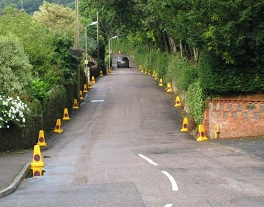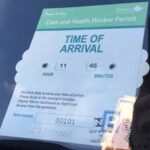Contents
Foreword

The management of parking is pivotal in supporting our network. It enables the Authority to balance the demand for on-street parking for businesses, residents and visitors with the safe and efficient movement of traffic.
Our team continues to meet the needs of our communities and network; delivering a sustainable and business-like service, with continuous improvement in service delivery and response to the changing needs of our communities. Regular review of delivery has resulted in efficiencies and smarter deployment at the times when there is the greatest need for parking management and greatest benefit to communities, visitors and businesses.
This year a key area of work was not only improving the delivery of our service to the public but also improving the experience for our team. The team invested in a number of engagement events looking at support and development, in particular with regards team structure, and also investing in technology to ensure the team had the best “tools” for the job.
Climate change remains a key focus for the Authority and our Traffic Management Team continues to contribute towards carbon reduction, not only by managing congestion and ensuring free movement of vehicles day to day but also developing Policies to encourage sustainable travel choices and assisting in the role out of on-street EV charging facilities.
Of course, as the year closed new challenges were arriving for all our teams as we prepared to respond to the emerging pandemic. I would like to thank the Parking and Enforcement Team (and wider Traffic Management Team) not only for their ongoing commitment to continuous improvement and innovation, but also their exceptional response over an extremely challenging. The service continues to develop and deliver.

Councillor Stuart Hughes
Cabinet Member for Highway Management
About Devon
Devon is the third largest county in England with Devon County Council covering 2,534 square miles of the county (the remaining areas being within the unitary authorities of Plymouth and Torbay). There are 8000 miles of highway within Devon; the biggest highway network of any authority in the country.

With major universities in Exeter and Barnstaple now attracting students from around the world, and two national parks Dartmoor and Exmoor as well as England’s only natural World Heritage Site, the Jurassic Coast which is well known for its unique geology and geographical features, Devon attracts nearly six million visitors per year and there are twice as many tourism businesses in Devon than the national average.
Our deployment prioritises key urban centres and their aerial routes where free flow of traffic is essential. It also recognises the needs of communities where a high demand for turnover of on-street spaces plays a vital role in maintaining economic viability.
Effective traffic management on this network is reliant on the placing of various restrictions including those affecting speed and parking.
Management of parking is essential to provide safe and expeditious movement of traffic through the network, and within Devon, limited waiting, pay & display, residents parking, and no waiting restrictions are used to manage parking stock with efforts focused in the 28 Devon market and coastal towns and the City of Exeter which are where most of our population resides.
The service uses customer feedback and enforcement information from previous years to improve our deployment on a countywide basis.
New beats are designed to ensure that larger communities requiring more frequent attendance are serviced regularly, and grouped with several smaller communities which are serviced cyclically in line with their parking management needs.
Grouping communities together allowed for a more efficient spread of resource to facilitate fewer CEO attendances whilst retaining a high level of service to all communities with parking management needs.
We deliver our service in line with the objectives of the Traffic Management Act 2004
Parking as a service
Our Parking Services Team comprises an enforcement team of civil enforcement officers deployed from 3 area bases, and a central team of appeals officers who consider challenges and appeals to Penalty Charge Notices (PCN) and oversee the management and issuing of on-street permits.
Our deployment prioritises key urban centres and their arterial routes where free flow of traffic is essential. It also recognises the needs of communities where a high demand for turnover of on-street spaces plays a vital role in maintaining economic viability.
The service recognises the challenges for the modern high street and sees the management of parking as a supporting complimentary service; ensuring parking is available to customers and turning over, whilst maintaining clear passage and access for deliveries and loading.
Our approach to parking enforcement is consistent, transparent, and informed by national best practice (including feedback received from the Traffic Penalty Tribunal).
The issue of a PCN is always a last resort with officers engaging with drivers whenever possible.
Our goal is to assist people to park; pick up; set down; load or unload conveniently and lawfully, to make our coastal communities, towns and city centres accessible to everyone.
We continue to use intelligence gathered through customer feedback, our ‘report it’ and request enforcement web forms and social media feeds to regularly review beat patterns to further enhance our service. Ensuring we attend when most needed and can respond to changing local needs.
Enforcement can be requested using our report a problem page.
Parking and Traffic Regulation Orders
Traffic Regulation Orders (TROs) are legal agreements that allow us (or the police) to enforce regulations including speed limits, on-street parking and one-way streets.
Most TROs are created with input from numerous stakeholders, including:
- elected members
- local communities
- police
- highways and parking officers
to address specific traffic congestion or quality of life issues.
The Traffic Orders, Policy and Programme team collate and prioritise requests for Community Traffic Management Plans, and then work with elected Members and other local stakeholders to design proposals which will then be put out to public consultation.
How TROs are created
There is a statutory procedure for creating a TRO. The introduction or removal of a traffic order can be lengthy and expensive process.
Design and consultation
We create a proposed design for the TRO and then consult on this with local councillors and parish councils, the emergency services and sometimes other institutions such as The Freight Transport Association, The Road Haulage Association and local public transport operators. Residents, traders and community groups who are likely to be affected are consulted where appropriate. Following an initial consultation with the main interested parties the proposal may be amended before being advertised.
Advertising the TRO
The notice of intention is published in a local newspaper and put up on-street furniture in the vicinity of the proposals. The notice has details of the proposals and contact details to enable comments to be submitted. Where appropriate we may also deliver notices to premises most likely to be affected the proposals.
The length of the consultation period is at least 21 days from the start date on the notice and the proposal can be viewed online and at a nominated council office. Objections and comments must be made online or by writing to the address in the notice.
Any objections and contentious issues are considered by a committee of the area’s local councillors who will review and consider those objections and comments and collectively decide whether to allow the scheme to proceed as advertised, make minor modifications to the scheme to resolve objections or abandon the proposal entirely.
The Covid-19 pandemic towards the very end of the 2019/2020 year forced us to suspend the advertisement of TROs. This pause allowed us to start to consider some different measures around the TRO advertising process. So, in addition to publishing a copy of the notice in the town’s local paper and putting up public notices, on-street furniture at regular intervals along the lengths of the affected roads, we considered sending a maildrop to residents in the immediate vicinity of every proposal.
Due to the immediate closure of many of the nominated council offices and the requirement for many, if not all, residents to remain at home we had to assess the need for all our deposit documents to be online and the length of time they are available.
Making the order
The TRO is formally made and introduced and a notice of making published.
More information about Traffic Regulation Orders and proposed schemes.
During the period covered by this report we have successfully implemented a number of new TROs.
Our regular ‘Local Waiting Restriction Programme’ includes a large number of requests from our county councillors, local town and parish councillors, the public and officers from our Neighbourhood Highways Teams.
These requests include locations that, due to the lack of resources, could not be processed through the TRO process on their own. Often the request is for a low-key amendment/correction to an existing restriction or the small-scale introduction/removal of a restriction. However, these minor improvements often have great significance to the immediate local community and help to resolve very localised problems.
Due to the number of locations contained in these TROs the areas covered are grouped within the boundaries of our eight Highways and Traffic Orders Committees (HATOC). Therefore during 2019/2020 we have undertaken eight extensive TROs as part of this ongoing programme.
We also have a programme of regular TROs to implement residential disabled bays for blue badge holders. Due to the number of requests we receive these TROs are usually processed four times a year.
We completed the TROs which enabled the introduction of Devon County Council’s first publicly available on-street electric vehicle charging points. This project will aim to bring 150 on-street charging points across Exeter.

During 2019/2020 we also completed a number of TROs for:
- Standalone TROs including the following schemes.
- Experimental TROs for schemes in; Clyst Honiton, Highweek, Den Crescent, Teignmouth
- Speed limit orders for; 30mph – East Budleigh B3178, South Devon Highway 50mph Extension, 30mph – Butcher Park Hill Tavistock, 20mph – Down Thomas, 40mph – Berry Down Cross Combe Martin, 40mph – Seaton Down Hill Seaton and 30mph – Callington Road Tavistock
- Individual TROs for waiting restrictions at; Long Lane Exeter Airport, Holland Rd & Kingsway (Langage~Sparkwell), Pebbleridge Road Westward Ho!
- A One-Way order for Old Rydon Lane (Sandy Park Hotel) Exeter
- We also implemented Article Changes to our consolidated TRO for Care Workers & Trade
- Additionally, we completed a Devon wide consolidation of our waiting restriction This brings together all the numerous orders we have made into one order. This helps everyone that refers to our TROs to easily find and identify restrictions in a particular location within a single document.
Furthermore, we implemented four new residents’ parking schemes.
Monks Road area in Exeter
Residents parking for the Monks Road area was first considered in 1999. Since then the Council consulted local residents in 2006 and 2015. On these three occasions the residents were not in favour of a scheme and the proposals were not progressed.
However, following the extension of a nearby zone in 2018, there was increasing requests from local residents to reconsider proposals. In January 2018 members considered a petition from residents of the area and agreed to consult residents on whether they would be supportive of a scheme. The results of the consultation were presented to the Exeter HATOC in April 2019 when it was resolved to advertise a scheme.
The statutory consultation for the traffic regulation order took place between May and June 2019. The consultation was advertised in the local paper, on-street and residents were sent a postcard. Details of the proposals were available at Exeter Civic Centre, County Hall, Mount Pleasant Health Centre and on the Council’s website.
During the consultation the council received 231 responses from 192 addresses. Of these 231 responses, 187 were from properties within the consultation area with the majority of these addresses (68%) in favour of the introduction of residents parking restrictions.
Nevertheless, after consideration of the comments a small number of the restrictions were slightly modified from those advertised.
The scheme was implemented in Oct 2019.
Rosebarn Lane area in Exeter
The Rosebarn Lane area of Exeter is near to the highly respected Exeter University and adjacent to an existing residents’ parking scheme. These factors contribute to displaced vehicles reducing available parking for the residents.
Following the receipt of a petition from residents requesting a Residents Parking scheme we undertook a consultation on an initial proposal. Detail proposals were then drafted and another consultation with the residents resulted in us receiving 427 submissions.
The scheme was implemented in Sept 2019 where the residents supported the proposals.

Topsham

This scheme was implemented in March 2020. As previously described in the 2018/2019 CPE Annual Report, the scheme aimed to free up as much on-street parking as possible to benefit residents and encourage longer term visitors to use off-street car parks.
The implementation followed the local Highways and Traffic Orders Committee resolution to reduce the scope of the proposed scheme to encompass the areas where residents were supportive of restrictions.
More information about the Topsham parking review consultation.
Bishops Court, Exeter
Bishops Court is a new housing development on the edge of Exeter within easy reach of the city centre, near Sandy Park (award winning conference/event venue and home ground to the Exeter Chiefs), close to the M5 junction 30, near a popular park & ride site and within walking distance of a centre of commerce.
As is often the case with a location such as this, the residents of the new development reported inappropriate parking from commuters and visitors to Sandy Park.
The layout of the development conveniently lent itself to a compact residents parking scheme.
Understandably the consultation submissions from the residents were all supportive of the proposal. The residents’ parking scheme was implemented in two phases with the second phase coinciding with the completion of the development.
The TRO for the first phase of the scheme was sealed in early 2019 and the second in late 2019.
Customer service
Transparency and providing clear information to our customers is a key objective of our service.
Our enforcement and appeals policies are regularly reviewed and are available to all on our open data page.
We continue to use customer feedback to shape and improve the information we provide and continue to expand communications by utilising corporate social media. This allows us to adapt as customers trend to communications on new platforms.
Corporate Twitter accounts
By using customer feedback, we also identified that visitors would benefit from a single source of information on parking whether that is our on-street facilities, or car parks offered in our sister district, borough, and city councils to help them plan their visit.
Parking and income remain an emotive topic for many. We hope by publicising what we do and how we use the public’s money in our annual parking reports we demonstrate our commitment to delivering an effective, responsible and sustainable service.
Our annual parking reports are archived here.
Cashless parking
The Council remains firmly committed to delivering the best value for money to our residents and visitors to the county.
The public’s appetite for cashless parking continues to grow. As more and more customers are choosing to pay electronically over cash for all their purchases, we need to adapt and make sure we offer a convenient way to all of our customers to buy their parking needs.
The use of our cashless parking services continues to increase and saw an average of 5% growth again over the previous year, making up 21% of the income from on-street parking charges.
We are continuing to review and rationalise the numbers of pay and display machines needed to provide our service to customers. Machines nearing the end of their useful lives are being retired from service and replaced by machines from low usage areas.
By recycling some of our existing stocks we are reducing our carbon impact, reducing on-costs for cash collection and maintenance which helps to maintain current pay and display tariffs at a sustainable level to support local businesses.
This has benefits for public realm (keeping the streetscape clear), and delivers a saving to the Council, in reduced operating costs, which in turn can be used to support other key transport initiatives across the county.
Where demand shows a need for a pay by cash option, we will continue to provide an option to pay by cash in that location.
The use of Pay & Display in new residential zones and in commercial areas will continue to form a key part of our traffic management considerations in consultation with residents and communities, but fewer physical payment machines will be deployed in the future responding to the increasing uptake of cashless options by customers.
The Council is looking at new technologies such as contactless touch pads, and app-based payments such as apple-pay, as possible alternative options to make paying for parking as easy and convenient as possible for the public.
Cashless payments as a percentage of all parking payments in the last three years
| Month | 19/20
% | 18/19
% | 17/18
% |
|---|---|---|---|
| Apr | 18.6 | 14.3 | 8.6 |
| May | 20.0 | 15.6 | 11.4 |
| Jun | 19.0 | 13.9 | 11.4 |
| Jul | 19.3 | 13.2 | 11.7 |
| Aug | 17.6 | 12.8 | 11.5 |
| Sep | 19.8 | 14.4 | 12.1 |
| Oct | 23.6 | 17.3 | 13.1 |
| Nov | 26.2 | 19.8 | 15.4 |
| Dec | 23.9 | 16.1 | 12.7 |
| Jan | 26.9 | 19.5 | 15.7 |
| Feb | 26.6 | 19.6 | 16.5 |
| Mar | 24.2 | 22.0 | 12.7 |
| Average | 21.6 | 16.5 | 12.7 |
Innovation and new developments
Care and Health Worker Permit Scheme
Originating from a meeting of the South Hams HATOC on 6 July 2018, it was identified that our exemptions for care workers provided limited assistance in some communities, notably Kingsbridge and Dartmouth. The Committee resolved to ask Cabinet to review the County position on this exemption.
Officers arranged a consultation to be carried out in October 2018 to identify if there are specific locations or communities where the existing exemptions did not assist staff and established there would be a tangible benefit for care providers by an extension to the scheme right across the county.
Officers also scheduled a series of meetings with various stakeholders in the care sector, social care and the NHS. The issues were not just limited to the two locations above. A questionnaire was circulated and there were 150 responses to it and based upon those responses it was clear that an alternative scheme was needed and would be welcomed
In December 2019 Cabinet approved a year’s trial of an enhanced exemption permit scheme for care and health workers and social care staff to replace the previous exemption scheme and widen it to include allowing the use of yellow line restrictions when no other parking options were readily available.
The Cabinet approved that the costs for the trial scheme would be met from the On-Street Parking Account and that a further consultation be undertaken during the trial to determine the demand and effectiveness of the scheme.

Working with Chipside’s MiPermit, the scheme is managed by use of digital technology and each user is issued a ‘virtual permit’ for one year, and a time clock permit to show the enforcement team of their on site arrival and when their period of parking commenced.
Team managers are responsible for managing their digital accounts and can self-manage changes and additions to their staff register.
Permits began to be delivered to applicants in January 2020 and new applications have been received throughout the year.
The scheme has been extremely well received by our own social service teams, the NHS, charities and private company providers, and proved a well-timed initiative as the COVID-19 crisis began to emerge across the country in the spring of 2020.
Our own scheme predated initiates that PATROL, the BPA and other governing bodies asked local authorities to provide for these critically important key workers in March 2020 and safeguard the NHS.
Nearly 10,000 permits have now been made available to care workers, medical and social workers, across multiple service providers around the county
Digital trade permits
The Council has provided a dispensation scheme for contractors and trades since 2015 where there was an essential need for their vehicle to be parked at their work site for the day.
There are two options for these permits, an annual permit to use when working in a parking place, for example, resident-only or pay and display spaces, and a flexible daily dispensation permit that could be used (subject to approval) to be exempted whilst parked on yellow lined restrictions, as well as in on-street parking spaces. More information is available at trade permits – dispensations.
The flexible scheme relied heavily on the contractor being able to forward plan work, as same day permits could not be made available and the applicant had to display a physical permit on the dashboard.
Applicants could choose the number of days they needed to park up to a maximum of 21 days. Over time the scheme had become less effective and was showing signs of abuse to obtain low-cost on-street parking, especially by non-essential vehicles.
The requirement to display a physical permit, and delays arising from late applications, notifications and the need for approval for use on yellow lines, created barriers to the tradespeople that were impacting on their ability to service their customer needs and time in challenging Penalty Charge Notices.
In December 2019 all recent users of our online dispensation scheme were alerted by email to a new enhanced service which we would launch in January 2020.
New charges would apply and options reduced to either a single day or a single week.
Working with Chipside’s MiPermit digital permit solutions, we started to issue digital permits to tradespeople in February 2020.
The new digital permit removes the need to display a physical permit and if to be used in an on-street parking space can now be bought on the day needed rather than in advance as was the previous case.
The application form has been enhanced to assist the applicant to identify what restrictions are at their intended work address and allows the applicant to buy the correct permit for their parking needs.
A daily trade permit provides permission to use any on-street resident permit only space or pay and display space and exempts the user from time limits if used in a limited waiting space.
A daily trade waiver exempts the holder in all of the above parking spaces and also exempts the holder to park on yellow lines if none of the aforementioned are available at the time of parking. The latter provides additional flexibility for the user, but the user does need to apply in advance of their arrival on-site.
As numbers of permits available at each road have a limit, where the number of permits allowable has been reached, the applicant is informed during the application process. Where a permit cannot be authorised for any reason the applicant is notified and any payment pending to the Council is returned automatically to the applicant.
The new digital permit is working well and delivered the improvements wanted based on feedback we have received from users.
Users create an account and can make changes to their permit vehicle details, to provide greater flexibility if more than one vehicle may be onsite at differing times or days during the week. By using a ‘basket option’ the account holder can buy additional weeks to extend their time on site, subject to the maximum numbers of permits allowed for that road/ location.
We now issue on average 500 of these permits or waivers to tradespeople each month.
The success of the digital trade permits has allowed us to utilise the digital technology to include issuing temporary permits at our discretion and inform proposals to move forward to managing resident parking permits digitally in 2021.
Residents’ Parking Working Group
Following on from work undertaken in 18/19 to audit residents’ parking permits in Exeter (to ensure that the scheme was functioning well for residents and any abuse of the system was being addressed), the Exeter Highways and Traffic Orders Committee (HATOC) requested that the working group continued to meet with a new focus on a future model for managing residents parking in the city to improve the system for residents, businesses and commuters whilst continuing to support the County Council’s work to reduce traffic congestion, improve air quality and reduce the impact on climate change.
In particular, it was requested that the group consider:
- a charging structure that could assist in achieving Local Transport Plan aims; promoting modal shift and sustainable transport, and reducing congestion and pollution
- a review of the Authorities position with regards eligibility of new developments and redevelopments in existing residents parking schemes
- appropriate parking provision for staff and visitors to schools in residents’ parking schemes
The working group met on a monthly basis to develop proposals throughout the year calling expert witnesses including representatives from the University. The group also sought guidance from the Authority’s legal team on legislation in relation to differential charges to discourage multiple car ownership and to encourage uptake of electric and low emission vehicles.
The group has committed to develop a range of recommended changes to policy to ensure this remains relevant and aligned with strategic aims. A report was scheduled for presentation in late 2020.
On-street charging facilities
In 18/19 Devon County Council formed a consortium with two private sector companies, ZAPINAMO and Gamma Energy, to install and operate 150 electric car charge points on the streets of Exeter over the next two years.
The £4m StreetHUBZ project will be delivered by ZAPINAMO, developers of a new generation of superfast car chargers. ZAPINAMO will design, build, install and maintain the EV ‘StreetHUBZ’ chargers and Gamma Energy will own and operate the infrastructure.
Throughout 19/20 officers worked closely with private sector partners to develop principles for identifying suitable locations within the city for charging points. Locations were identified based on Cenex for suitability based on the following factors:
- Vehicle ownership: vehicles per person as a relative indicator of vehicle ownership.
- Vehicle usage: method and distance of commute as driver or passenger.
- Affluence: number of households deprived on one or more dimensions, socio-economic classification.
- Off-street parking availability: households by building type with the assumption that terraced or flats have no off-street parking provision.

After site review and consideration of electrical connection, road safety and ensuring clear passage for users of the footway 11 sites with a total of 44 charging opportunities were identified for inclusion in the first tranche. Most locations will also include a new EV Co-Cars facility.
The first tranche will be advertised in 20/21. It is hoped that on-street charging places will encourage more people without off-street parking to take up EV ownership. The new facilities will be supported by managed on-street parking bays to ensure that users enjoy easy access and abuse of the bays is addressed.
Find out more at www.rapidchargingdevon.co.uk.
Working with others
Cashless parking joint tender
Towards the end of 2018, with our cashless parking contract due to end in December 2019, we began to hold conversations with our neighbouring councils about their cashless parking contract end dates, to see if an opportunity to work together and jointly procure was a possibility.
Our neighbours also had contracts due to end at different dates in 2019, and agreed that there was indeed an opportunity to jointly procure, and more importantly an opportunity to award a single contract to one company, that could be used by customers of the districts, Exeter City Council and our on-street customers right across the whole of the county of Devon.
Torbay Council kindly offered to act as the lead authority, compiling the bespoke specification needs of each council that would need to be incorporated: location and tariff data, volumes of transactions, start/stop functionality, evening only charging, bank holiday charging variances, security and GDPR.
The invitation to tender would be a challenging document to construct, and a considerable length of time was taken in ensuring it met the nine authority’s needs. Ongoing meetings and discussions were held periodically throughout 2019 with a final agreed invite to tender published in February 2020.
Our shared goal to make use of a single service provider countywide and make cashless parking a real alternative to paying by cash, was enhanced by a desire to see no ‘convenience’ charges incurred by the end user. They should pay the same price for their parking session, no matter how they paid.
The COVID-19 crisis in March forced the award of this new contract to be delayed until the summer of 2020.
Exeter City Council joint appeals services
Discussions about exchanging services for parking enforcement were ongoing from 2018 until spring 2019.
Exeter City had lost some of their appeals staff when Devon brought on-street enforcement services in house in 2014. Due to leavers at the City Council, they found themselves without trained officers to deal with appeals and approached Devon for some support.
Around the same time the County Council was looking to find a new operational base for its civil enforcement officers, and Exeter had unused office space, previously used for the on-street service provision prior to 2014 that they had been unable to find a new tenant for.
In September 2019, Devon’s parking appeals team took on the extra responsibility for considering appeals received against Penalty Charge Notices issued by the City Council for contraventions in their car parks. We further provided Exeter City Council with enforcement devices linked to the Chipside case manager software, to enable them to undertake more enforcement of their car parking estate.
The agreement between both councils sees Devon providing appeals support, TPT case preparation and debt recovery processes, along with any enforcement supplies required in exchange for rental charges for the office space we utilise in one their car parks.
The arrangement has been based on a ‘base number’ of PCNs issued and the number of likely appeals to be received. Should the number of PCNs issued by the City Council exceed the agreed numbers, the councils have agreed an additional price to be paid by the City Council per PCN challenged or appealed.
There have been some discussions about the possibility of on-street officers also undertaking some car park enforcement of the city’s outlying surface car parks, and those in primarily more residential areas. It makes sense to use one enforcement officers time when visiting the on-street parking to divert into an adjacent car park, rather than send an Exeter car park officer to that location as well.
The pandemic has stalled the talks on widening the shared opportunities currently, but the County Council is happy to discuss offering our services to our neighbouring authorities where services would be enhanced and efficiencies or savings be made by both sides.
Developing the service
A new vision
In April 2014 the enforcement of on-street parking in Devon transferred in-house. In 2019 we had delivered the project to ensure a viable in-house service. In 2019 we launched a vision for the future of the service focusing on:
- people and culture
- customer engagement
- training and development
- technology
- performance management
The vision was created with the input of the team and key stakeholders and shifted the focus of the service to measure and manage success by meeting the objectives of those customers who value the service, focusing on quality and consistency and investing in ensuring professionalism in delivery.
Primary to this was a planned restructure of the team creating supervisory roles to coach and support manageable sized teams through regular one to ones measuring the individual quality of delivery.
Through restructuring three teams into two Central (Exeter city and surrounding area) and Rural (the rest of Devon) we introduced two more strategically focussed team manager roles to enable the delivery of enforcement coverage to meet
customers’ needs and the ability to introduce new proposals to aid closer working with local schools and the police.
This restructure would enable a focus on performance, reinforcing the behaviours required of employees, leading to some colleagues moving on to other roles whilst we introduced the framework of the new structure and the investment in new team members who were able to support a positive working environment.
The vision also informed a business case to expand the team to meet the demand for enforcement and deliver KPIs developed to shift the team delivery to customers that were engaged with the service and ensuring quality – getting it right first-time to reduce potential costs and impacts of errors, all aiding the development of closer community working.
New KPIs
- 80% of reactive and actionable customer requests attended and responded to within five days and 99% within 28 days
- Delivery of 85% of coverage against plan
- 100% of PCNs issued correctly
- 100% of CEOs consistently achieving above 80% of set quality standard
- 80% of pay and display machine’s visited with feedback within 24 hours of failure report
Technology
We completed the rollout of new handhelds to every team member to ensure consistency and fairness across the teams and upgraded the team from using a standard mobile phone to a smartphone.
This enabled the introduction of TEAMs to ensure clear communication, collaboration and connection with colleagues whilst lone-working and provided access to information whilst on-street to aid speedy resolution of issues and escalation to other teams where necessary.
Training
We invested in a bespoke programme of training covering conflict management and customer service. This was received well and used a different approach to offer tools that can be used on-street. This was delivered in two phases to enable frontline staff to utilise the training, practise on-street and feedback on what worked for them.

We worked with our e-learning provider to develop online knowledge to support the conflict management and customer service training as well as knowledge on service risk assessments and the service Standard Operating Procedures, creating a knowledge test, primarily for new starters, but available for all existing staff to ensure they are able to test their on-street enforcement knowledge.

We also held a team event to launch the new vision and a follow-up event to provide updates on progress and define a team charter to underpin the next year’s appraisal. We held awards at the end of the year focusing on rewarding behaviours and performance across the team and creating opportunity for the whole team to get together and meet colleagues they rarely encounter.
We have continued to support two team members through Level 5 Management apprenticeships and introduced a coaching programme through the 121s for staff who requested development into a supervisory role, enabling shadowing and coaching in some of the elements of this role.
We have also supported other departments in training on parking. We held several training events with the Customer Service Centre and with the Highways Services Team. These teams both handle the front-line element for the service and in delivering this training increased confidence in handling queries at first point – further underlining our ‘right first time’ approach.
Engagement
We carried out a trial, working in partnership with the police and a local school encountering parking issues.
This comprised of repeated attendance and engagement with parents at drop off and collection times over a two-week period. The event was well-received and led to a short-term change in behaviour outside the school.
The success of this led to further requests from schools encountering similar difficulties, which we aim to progress when staffing of the new structure is completed.
We attended the annual Parish Council Conferences to meet and discuss enforcement issues across the county, which was well-received, and enabled increased understanding of the approach of enforcement and dispelled some misconceptions of the service.
We worked with our strategic recruitment team to expand our strategy, ensuring we tapped into a diverse pool through advertising, using varied media to attract demographics that may not previously have applied to the role on-street, and employed some of our existing enforcement officers to head the campaign.
We held a programme of focus groups involving the team throughout the year to discuss issues and provide solutions to fundamental areas such as improving communication and using technology to ensure consistency across the teams.
Throughout the year we worked with counterparts across team to manage the on-street defects and TRO issues. A source of frustration for front-line staff and customers, we introduced an online reporting tool, enabling the officer on-street to record everything required by the technician to raise the order and a KPI to ensure ongoing management and progress of these elements.
Investment in our team
The addition of new uniform elements such as shorts and a variety of CEO high-vis vests to ensure not only that the team looked professional but that the uniform provision aided wellbeing on-street, ensuring comfort in all weathers and providing back support.
Likewise, we started a fleet management programme to enable the renewal of our fleet vehicles over the next five years to ensure the front-line team had a clean and safe vehicle from which to operate.
To increase the visibility and access to report a health and safety ‘near-miss’ we have adopted an online reporting tool for front-line staff to report these directly. In line with the conflict management training, this has improved the attitude and culture of the team towards their own wellbeing and the visibility of incidents encountered on-street.
To support staff with these incidents we also launched a new process to proactively contact a business about an employee’s conduct towards our staff and over the year businesses have been very supportive of this approach.

Enforcement statistics
Parking statistics
| Parking spaces | Number |
|---|---|
| Volume of on-street parking spaces | 26780 |
| Volume of off-street parking spaces | 1584 |
Penalties issued
| Penalties issued | Number |
|---|---|
| Total numbers of PCNs issued | 72314 |
| Number of PCNs at high level | 39173 |
| Number of PCNs at low level | 32571 |
| Number of Reg 9 PCNs issued | 71483 |
| Number of Reg 10 PCNs issued | 261 |
| Number of PCNs issued on-street | 71744 |
| Number of PCNs issued off-street | 570 |
Penalties paid
| Penalties paid | Number |
|---|---|
| Number of PCNs paid | 53586 |
| Number Paid at discount | 46177 |
| Number of PCNs before charge certificate (within 56 days) | 6191 |
| Number paid after charge certificate served | 1218 |
| Number of charge certificates registered | 11463 |
| Number of warrants of execution issued | 9304 |
| Number of PCNs cancelled | 3921 |
| Number of PCNs written off | 1783 |
Penalties challenged
| Penalties challenged | Number |
|---|---|
| Number of PCNs resulting in informal challenge | 12976 |
| Number of PCNs cancelled as a result of informal challenge | 5124 |
| Number of informal challenges rejected | 6587 |
| Number of PCN’s resulting in a formal representation | 2582 |
| Number of formal representations which resulted in the cancellation of the PCN | 488 |
| Number of formal representations which resulted in a notice of rejection | 789 |
| Number of PCNs written off for other reasons (for example, CEO error or DVLA untraceable) | 2047 |
| Number of vehicles immobilised | 0 |
| Number of vehicles removed | 0 |
Cases referred to the Traffic Penalty Tribunal
| Appeals | Number |
|---|---|
| Total number of appeals | 150 |
| Number of appeals allowed | 58 |
| Number of appeals dismissed | 49 |
| Number of appeals not contested | 8 |
| Cases awaiting decisions | 35 |
Top 20 locations for PCNs to be issued 2019/2020
| Location | Number issued |
|---|---|
| Southernhay East, Exeter | 2383 |
| Southernhay West, Exeter | 1607 |
| Sidwell Street, Exeter | 1305 |
| Musgrave Row, Exeter | 1223 |
| George Street, Exeter | 995 |
| Queen Street, Newton Abbot | 994 |
| South Street, Exeter | 745 |
| Queen Street, Exeter | 713 |
| Red Lion Lane, Exeter | 694 |
| North Street, Exeter | 611 |
| Dixs Field, Exeter | 610 |
| King William Street, Exeter | 571 |
| High Street, Honiton | 556 |
| Bailey Street, Exeter | 502 |
| West Street, Exeter | 451 |
| Fore Street, Exeter | 432 |
| Fore Street, Totnes | 410 |
| Fore Street, Kingsbridge | 409 |
| County Hall, Exeter (off-street) | 384 |
| Acland Road, Exeter | 380 |
| Total | 72,314 |
Top 20 locations for PCNs to be issued 2018/2019
| Location | Number issued |
|---|---|
| Southernhay East, Exeter | 2128 |
| Southernhay West, Exeter | 1258 |
| Queen Street, Newton Abbot | 839 |
| George Street, Exeter | 820 |
| Sidwell Street, Exeter | 760 |
| Musgrave Row, Exeter | 767 |
| South Street, Exeter | 633 |
| Boutport Street, Barnstaple | 601 |
| Queen Street, Exeter | 549 |
| North Street, Exeter | 479 |
| County Hall, Exeter (off-street) | 451 |
| Fore Street, Kingsbridge | 403 |
| Dixs Field, Exeter | 384 |
| Fore Street, Totnes | 387 |
| Stover Court, Exeter | 376 |
| West Street, Exeter | 366 |
| Fore Street, Exeter | 366 |
| Bailey Street, Exeter | 358 |
| Esplanade, Exmouth | 350 |
| Red Lion Lane, Exeter | 347 |
| Total | 69,694 |
Top 10 contravention codes used 2019/2020
| Reason | Quantity issued |
|---|---|
| 01 Parked in a restricted street | 16,369 |
| 30 Parked for longer than permitted | 13,835 |
| 12 Parked in a residents’ place | 9,095 |
| 06 Parked without clear display of ticket | 4,201 |
| 25 Parked in a loading bay | 2,723 |
| 05 Parked after expiry of payment time | 2,226 |
| 02 Loading in a restricted street | 1,821 |
| 19 Parked in a residents’ place | 1,459 |
| 40 Disabled person’s parking | 1,320 |
| 11 Parked without payment | 1,110 |
Top 10 contravention codes used 2018/2019
| Reason | Quantity issued |
|---|---|
| 30 Parked for longer than permitted | 15,173 |
| 01 Parked in a restricted street | 15,160 |
| 12 Parked in a residents’ place | 9,179 |
| 06 Parked without clear display of ticket | 5,202 |
| 25 Parked in a loading bay | 2,906 |
| 05 Parked after expiry of payment time | 2,337 |
| 02 Loading in a restricted street | 1,772 |
| 19 Parked in a residents’ place | 1,421 |
| 40 Disabled person’s parking | 1,421 |
| 22 Re-parked in the same place | 490 |
Financial summary
| 19/20 | 18/19 | 17/18 | 16/17 | 15/16 | |
|---|---|---|---|---|---|
| PCNs issued | 72,314 | 70,115 | 75,308 | 68,947 | 65,008 |
| Income | £2,407,543 | £2,141,517 | £2,273,858 | £2,186,616 | £2,166,235 |
| Expenditure | £2,203,475 | £2,163,245 | £2,163,324 | £1,896,928 | £1,831,023 |
| Surplus/Deficit | £204,068 | -£21,728 | £110,534 | £289,688 | £335,212 |
| Income 2019/20 | £ |
|---|---|
| Income collected from on-street parking charges | £3,451,574 |
| Income from Penalty Charge Notices | £2,407,543 |
| Income from permits | £959,140 |
| TOTAL | £6,818,257 |
| 19/20 | 18/19 | 17/18 | 16/17 | 15/16 | |
|---|---|---|---|---|---|
| Staffing | £1,806,602 | £1,731,763 | £1,782,062 | £1,515,374 | £1,453,951 |
| Accommodation | £30,177 | £25,021 | £9,645 | £12,954 | £7,525 |
| Fleet and travel | £101,062 | £103,104 | £77,339 | £55,881 | £106,651 |
| IT | £35,325 | £32,854 | £28,174 | £40,637 | £59,275 |
| Stationery | £48,119 | £138,253 | £142,201 | £95,152 | £90,209 |
| Debt recovery | £75,471 | £51,383 | £60,000 | £60,000 | £53,795 |
| Other | £106,718 | £80,867 | £63,903 | £116,930 | £49,609 |
| One-off set up costs | £0 | £0 | £0 | £0 | £10,008 |
| TOTAL COST | £2,203,475 | £2,163,245 | £2,163,324 | £1,896,928 | £1,831,023 |
| TOTAL PCN INCOME | £2,407,543 | £2,141,517 | £2,273,858 | £2,186,616 | £2,166,235 |
How do we spend our money?
The financial aspects of our service are managed through the ‘On-Street Parking Account’.
The On-Street Parking Account consists of two elements:
- Income from ‘Pay & Display’ and other charges
- Surplus or deficit from on-street CPE (enforcement)
Income from the ‘On-Street Parking Account’ is used to fund the maintenance and development of parking management schemes and a limited number of other traffic and transport-related services in accordance with the criteria for funding prescribed in Section 55 of the Road Traffic Regulations Act 1984, with surpluses used for:
- the provision or operation of public transport services
- the provisions of facilities for public transport services
- highway or road improvement projects
- environmental improvements
View the full County Road Highway Maintenance Revenue Budget and On-street Parking Account
| Scheme | Allocation £000s |
|---|---|
| TCS: Bus, Rail and Community Transport Support | 2,411 |
| CPE: Road Signs and Road Markings | 225 |
| Traffic Management Plans | 50 |
| Disabled Parking Bays | 100 |
| Cyclic Maintenance – Environmental Improvement | 2,200 |
| Traffic and Parking IT Systems | 10 |
| Safety Camera Partnership | 10 |
| Real-Time Passenger information | 78 |
| Variable Message Signs | 10 |
| Road Safety Improvements – Reactive | 50 |
| Park & Ride Business Rates/Site Maintenance | 110 |
| Country Parks | 219 |
| TOTAL | 5,473 |
Contact
Traffic Management Team
Great Moor House
Bittern Road
Exeter
EX2 7NL
Tel: 0345 155 1004
Email: trafficpolicy@devon.gov.uk
